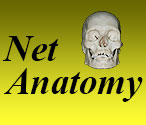
When first encountering a cross-sectional image, whether a cadaveric specimen or a CT scan, first identify the general body region from which the image is derived, i.e. head, thorax, etc. The body region is usually readily evident based on the shape and size of the cross-section coupled to readily identifiable region-specific structures such as the brain, lungs, etc. Also remember the conventional CT orientation of the image, i.e. anterior surface of the body is up, posterior surface is down, right side of the body to your left, left side of the body to your right. Next narrow the general body region down into smaller sub-regions or levels. This is accomplished by noting 1) the presence or absence of organs and 2) the shape and size of organs. For example, consider the two thoracic cross-sections below, one from the upper (superior) region of the thorax (image 1) and one from the lower (inferior) region of the thorax (image 2).

The lungs (L) in the upper region of the thorax (image 1) comprise a much smaller cross-sectional area than they do in the lower region of the thorax (image 2). Note also the presence of the trachea and absence of the heart (H) in the upper thorax (image 1); in contrast the lower thorax (image 2) lacks the trachea but possesses the heart. As your knowledge of gross anatomy grows, so will your ability to further subdivide body regions viewed in cross-section. For example, the trachea terminates by bifurcating into two main bronchi near the level of the T4-T5 intervertebral disc. Thus based on knowledge relating to the major respiratory passages, image 1 is above the T4-T5 disc (a thoracic region called the superior mediastinum) while image 2 is below the T4-T5 disc (a thoracic region called the inferior mediastinum).
Note too the relative position and shape of individual organs present in cross-section. For example the trachea lies in the midline, the lungs occur laterally in the thoracic cavity, etc. Pathologies observed in CT scans are deviations from the expected cross-sectional position, size, and shape of organs or the presence of new structures such as tumors. Most importantly the study of cross-sectional anatomy should not occur in a vacuum. Cross-sectional anatomy is based on three-dimensional gross anatomy that is viewed in a two-dimensional axial plane - it is essential that you have, or are concurrently developing, a through understanding of human gross anatomy.